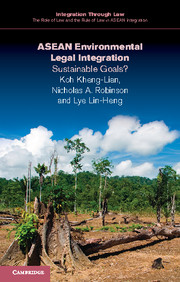Book contents
- Frontmatter
- Contents
- List of tables
- General editors’ preface
- Foreword – Professor Tommy
- Acknowledgments
- Introduction: exploring environmental law in Southeast Asia
- 1 ASEAN and environmental sustainability
- 2 Integrating sustainability into ASEAN state practice
- 3 The environment in the ASEAN region
- 4 Environmental sustainability laws in the ASEAN member states
- 5 ASEAN collaboration towards environmental sustainability
- 6 ASEAN and climate disruption
- 7 Conclusions: ASEAN's challenging way forward
- Executive summary
- Appendix A ASEAN organizational structure relevant to the environment – the ASEAN Charter
- Appendix B Founding of ASEAN – a short history
- Index
5 - ASEAN collaboration towards environmental sustainability
Published online by Cambridge University Press: 05 April 2016
- Frontmatter
- Contents
- List of tables
- General editors’ preface
- Foreword – Professor Tommy
- Acknowledgments
- Introduction: exploring environmental law in Southeast Asia
- 1 ASEAN and environmental sustainability
- 2 Integrating sustainability into ASEAN state practice
- 3 The environment in the ASEAN region
- 4 Environmental sustainability laws in the ASEAN member states
- 5 ASEAN collaboration towards environmental sustainability
- 6 ASEAN and climate disruption
- 7 Conclusions: ASEAN's challenging way forward
- Executive summary
- Appendix A ASEAN organizational structure relevant to the environment – the ASEAN Charter
- Appendix B Founding of ASEAN – a short history
- Index
Summary
ASEAN shall promote sustainable development so as to ensure the protection of the region's environment, the sustainability of its natural resources, and the preservation of its cultural heritage and the high quality of life of its people.
ASEAN Charter, Article 1(9)ASEAN's agenda for developing environmental policy and law began in 1978 (ASEAN Sub-Regional Environment Programme, Phase I) not long after the Stockholm Conference on the Human Environment ushered in the modern era of international environmental law in 1972. The journey from 1978 culminating in the Cha-Am Hua Hin Declaration on the ASEAN Roadmap for an ASEAN Community 2009–2015 established the interlocking ASEAN Political-Security Community (APSC), ASEAN Economic Community (AEC) and ASEAN Socio-Cultural Community (ASCC), and the Initiative for ASEAN Integration Strategic Framework and IAI Work Plan 2 (2009–2015) intended to bring Cambodia, Lao PDR, Myanmar and Vietnam to a level where they are able to implement the Roadmap. The ASCC Council oversees the overall implementation of the ASCC and ensures coordination and cooperation across all other communities.
It is not possible to survey all the areas of work envisaged in the ASCC and other Communities on environmental sustainability. This chapter traces the cooperation and collaboration within ASEAN itself, as well as with organizations outside ASEAN. These measures complemented and helped to reinforce or even to stimulate the establishment of national environmental law and programs in the various ASEAN member states, described above in Chapter 4. In assessing the various levels of environmental integration, this chapter evaluates the gaps and obstacles along ASEAN's path toward building an integrated environmental sustainability system. A significant approach that underpins all decisions is the ASEAN Way, which has its origin in the Treaty of Amity and Cooperation in Southeast Asia of 1976. The Treaty provides a set of norms for promoting cooperation in furtherance of peace, harmony and stability.
Regional security has become more complex than appeared to be the case in 1976. Concerns for traditional military security, as evidenced in the Indochinese and Vietnam Wars, is matched by non-traditional concerns.
- Type
- Chapter
- Information
- ASEAN Environmental Legal IntegrationSustainable Goals?, pp. 126 - 175Publisher: Cambridge University PressPrint publication year: 2016



